The compact SUV segment is getting increasingly competitive, and two of the most notable contenders are the Hyundai Tucson and the Kia Sorento. Both vehicles offer impressive features, innovative technologies, and strong performance, making them appealing choices for families and adventure-seekers alike. In this article, we'll delve into a detailed comparison of these two popular SUVs, focusing on their technical aspects, innovations, and what sets them apart from one another.
Hyundai Tucson vs Kia Sorento – Differences & prices compared
Everyday use, family trips or long-distance drives – here’s where the differences show.
Discover whether Hyundai Tucson or Kia Sorento fits your lifestyle better.
Design and Dimensions
The Hyundai Tucson measures 4510 mm in length, 1865 mm in width, and stands at 1650 mm high. Its sleek, modern design is complemented by a bold front fascia and smooth curves, projecting an athletic stance on the road.
On the other hand, the Kia Sorento is slightly larger, measuring 4815 mm in length and 1900 mm in width, with a height of 1695 mm. This extra size provides a more imposing presence, along with increased interior space and versatility. Both models feature five doors, allowing easy access to the cabin.
Engine Options and Performance
The Hyundai Tucson offers a range of engine types, including Diesel MHEV, Petrol MHEV, Petrol, Full Hybrid, and Plugin Hybrid configurations, catering to varied driving needs. The power outputs range from 136 to 252 HP, with multiple transmission options including both manual and automatic gearboxes. Acceleration from 0-100 km/h varies between 7.9 to 11.6 seconds, showcasing its capability depending on the chosen variant. The Tucson’s torque figures extend from 320 Nm to an impressive 367 Nm.
In contrast, the Kia Sorento also offers a versatile engine lineup, featuring Plugin Hybrid, Full Hybrid, and Diesel variants with power outputs ranging from 194 to 252 HP. Its sole automatic transmission simplifies the driving experience. The Sorento's acceleration from 0-100 km/h can be as quick as 8.8 seconds, showcasing a robust performance, especially for a family-sized SUV. Torque ranges from 367 Nm to a notable 440 Nm, providing confidence in towing and off-road conditions.
Fuel Efficiency and Consumption
When it comes to fuel efficiency, the Hyundai Tucson shines with its range of hybrid and plug-in options. It boasts a consumption range starting from as low as 1.0 L/100 km for the hybrid variants, making it a smart choice for those concerned about fuel costs. Moreover, its electric range can go up to 70 km, allowing for clean, short-distance commutes.
The Kia Sorento, while still efficient, has slightly higher consumption figures, with some models reaching up to 6.8 L/100 km. Its electric range is commendable, with a maximum capability of 55 km, making it suitable for urban driving. Both SUVs offer excellent fuel tank capacities, with the Tucson reaching up to 54L and the Sorento slightly higher, up to 67L, allowing for extended travel between refuels.
Interior and Technology
Inside the Hyundai Tucson, you'll find a modern, spacious cabin designed with user comfort in mind. It accommodates up to five passengers and features quality materials throughout. The digital cockpit, large touchscreen display, and advanced infotainment system with Android Auto and Apple CarPlay integration make for a highly enjoyable driving experience.
The Kia Sorento ups the ante with options for five, six, or even seven seats, allowing for great flexibility depending on your needs. Its interior offers premium materials, enhanced ergonomics, and a robust infotainment system paired with a larger display compared to the Tucson. The Sorento also includes numerous driver-assist technologies that enhance safety and convenience.
Safety Features and Ratings
Both the Hyundai Tucson and Kia Sorento come packed with an array of advanced safety features. Key technologies include adaptive cruise control, lane-keeping assist, blind-spot monitoring, and automatic emergency braking. They are designed to protect occupants and improve driving comfort, making both vehicles a smart choice for families.
Conclusion: Which SUV Reigns Supreme?
Ultimately, the decision between the Hyundai Tucson and Kia Sorento comes down to individual needs and preferences. The Tucson impresses with its fuel-efficient hybrid options and sleek design, making it ideal for those looking for an agile and economical vehicle. In contrast, the Sorento's versatility, spaciousness, and higher performance capabilities may appeal more to those who prioritize passenger capacity and additional power.
Both SUVs offer a compelling combination of innovation, safety, and performance, proving that whether you choose the Tucson or the Sorento, you cannot go wrong in this competitive automotive landscape.
Here’s where it gets real: The technical differences in detail
Costs and Efficiency:
When it comes to price and running costs, the biggest differences usually appear. This is often where you see which car fits your budget better in the long run.
Hyundai Tucson has a significantly advantage in terms of price – it starts at 30600 £, while the Kia Sorento costs 46000 £. That’s a price difference of around 15386 £.
Fuel consumption also shows a difference: Hyundai Tucson manages with 1 L and is therefore clearly more efficient than the Kia Sorento with 1.60 L. The difference is about 0.60 L per 100 km.
As for range, the Hyundai Tucson performs evident better – achieving up to 70 km, about 15 km more than the Kia Sorento.
Engine and Performance:
Power, torque and acceleration say a lot about how a car feels on the road. This is where you see which model delivers more driving dynamics.
Both models deliver identical power – 252 HP each.
In acceleration from 0 to 100 km/h, the Hyundai Tucson is a bit quicker – completing the sprint in 7.90 s, while the Kia Sorento takes 8.80 s. That’s about 0.90 s faster.
In terms of top speed, the Hyundai Tucson performs minimal better – reaching 204 km/h, while the Kia Sorento tops out at 201 km/h. The difference is around 3 km/h.
There’s also a difference in torque: Kia Sorento pulls slightly stronger with 440 Nm compared to 379 Nm. That’s about 61 Nm difference.
Space and Everyday Use:
Whether family car or daily driver – which one offers more room, flexibility and comfort?
Seats: Kia Sorento offers distinct more seating capacity – 7 vs 5.
In curb weight, Hyundai Tucson is evident lighter – 1542 kg compared to 1854 kg. The difference is around 312 kg.
In terms of boot space, the Kia Sorento offers a bit more room – 705 L compared to 620 L. That’s a difference of about 85 L.
In maximum load capacity, the Kia Sorento performs a bit better – up to 2100 L, which is about 301 L more than the Hyundai Tucson.
When it comes to payload, Kia Sorento distinct takes the win – 684 kg compared to 545 kg. That’s a difference of about 139 kg.
Who wins the race?
The Hyundai Tucson proves to be dominates this comparison and therefore becomes our DriveDuel Champion!
Hyundai Tucson is the better all-rounder in this comparison.
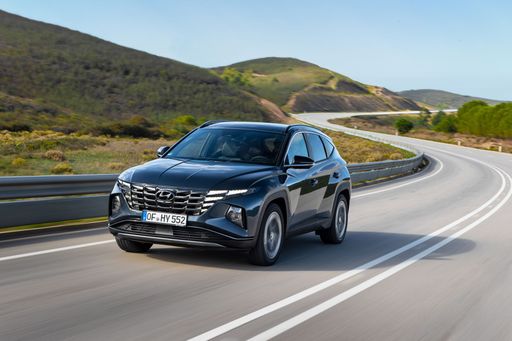 @ Hyundai Motor Company
@ Hyundai Motor Company
Hyundai Tucson
Hyundai Tucson
Hyundai Tucson marries bold, sculpted looks with a clever, roomy cabin that feels smarter than its price tag suggests. It's composed on the road, easy to live with day-to-day, and a sensible choice for buyers who want SUV style without the showroom theatrics.
details @ Hyundai Motor Company
@ Hyundai Motor Company
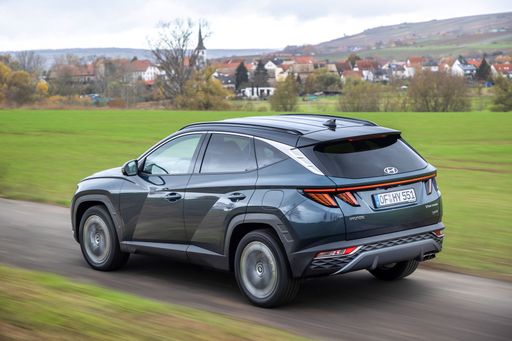 @ Hyundai Motor Company
@ Hyundai Motor Company
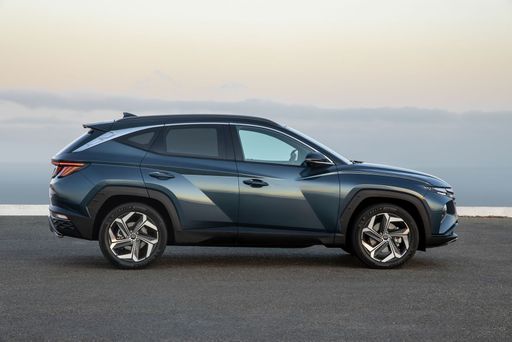 @ Hyundai Motor Company
@ Hyundai Motor Company
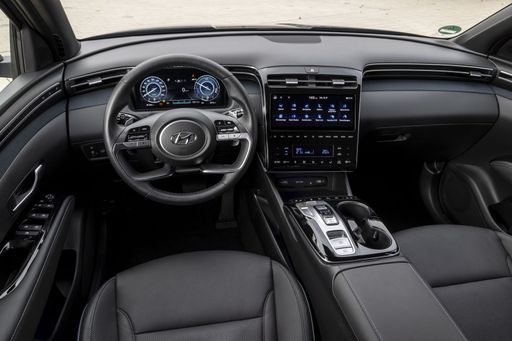 @ Hyundai Motor Company
@ Hyundai Motor Company
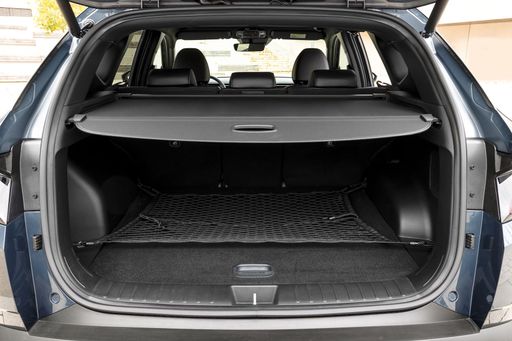 @ Hyundai Motor Company
@ Hyundai Motor Company
Kia Sorento
The Kia Sorento is a versatile SUV that seamlessly blends style and practicality, making it an appealing choice for families and adventurers alike. With its spacious interior and thoughtful design features, it ensures a comfortable driving experience on both urban roads and country excursions. Additionally, the Sorento offers a suite of advanced safety technologies, enhancing peace of mind for its passengers.
details @ Kia Corporation
@ Kia Corporation
 @ Kia Corporation
@ Kia Corporation
 @ Kia Corporation
@ Kia Corporation
 @ Hyundai Motor Company
@ Hyundai Motor Company
|
 @ Kia Corporation
@ Kia Corporation
|
|
|
|
Costs and Consumption |
|
|---|---|
|
Price
30600 - 46300 £
|
Price
46000 - 59300 £
|
|
Consumption L/100km
1 - 7.6 L
|
Consumption L/100km
1.6 - 7.2 L
|
|
Consumption kWh/100km
-
|
Consumption kWh/100km
-
|
|
Electric Range
64 - 70 km
|
Electric Range
55 km
|
|
Battery Capacity
-
|
Battery Capacity
-
|
|
co2
22 - 172 g/km
|
co2
37 - 174 g/km
|
|
Fuel tank capacity
42 - 54 L
|
Fuel tank capacity
47 - 67 L
|
Dimensions and Body |
|
|---|---|
|
Body Type
SUV
|
Body Type
SUV
|
|
Seats
5
|
Seats
5 - 7
|
|
Doors
5
|
Doors
5
|
|
Curb weight
1542 - 1889 kg
|
Curb weight
1854 - 2105 kg
|
|
Trunk capacity
546 - 620 L
|
Trunk capacity
175 - 705 L
|
|
Length
4510 - 4535 mm
|
Length
4810 - 4815 mm
|
|
Width
1865 mm
|
Width
1900 mm
|
|
Height
1650 mm
|
Height
1695 mm
|
|
Max trunk capacity
1721 - 1799 L
|
Max trunk capacity
1988 - 2100 L
|
|
Payload
523 - 545 kg
|
Payload
455 - 684 kg
|
Engine and Performance |
|
|---|---|
|
Engine Type
Diesel MHEV, Plugin Hybrid, Petrol, Full Hybrid
|
Engine Type
Plugin Hybrid, Full Hybrid, Diesel
|
|
Transmission
Automatic, Manuel
|
Transmission
Automatic
|
|
Transmission Detail
Dual-Clutch Automatic, Automatic Gearbox, Manual Gearbox
|
Transmission Detail
Automatic Gearbox, Dual-Clutch Automatic
|
|
Drive Type
Front-Wheel Drive, All-Wheel Drive
|
Drive Type
All-Wheel Drive, Front-Wheel Drive
|
|
Power HP
136 - 252 HP
|
Power HP
194 - 252 HP
|
|
Acceleration 0-100km/h
7.9 - 11.6 s
|
Acceleration 0-100km/h
8.8 - 9.7 s
|
|
Max Speed
180 - 204 km/h
|
Max Speed
183 - 201 km/h
|
|
Torque
250 - 379 Nm
|
Torque
367 - 440 Nm
|
|
Number of Cylinders
4
|
Number of Cylinders
4
|
|
Power kW
100 - 185 kW
|
Power kW
142 - 185 kW
|
|
Engine capacity
1598 cm3
|
Engine capacity
1598 - 2151 cm3
|
General |
|
|---|---|
|
Model Year
2024 - 2025
|
Model Year
2024
|
|
CO2 Efficiency Class
E, B, F, D
|
CO2 Efficiency Class
B, E, F
|
|
Brand
Hyundai
|
Brand
Kia
|
What drive types are available for the Hyundai Tucson?
Available configurations include Front-Wheel Drive or All-Wheel Drive.
The prices and data displayed are estimates based on German list prices and may vary by country. This information is not legally binding.
